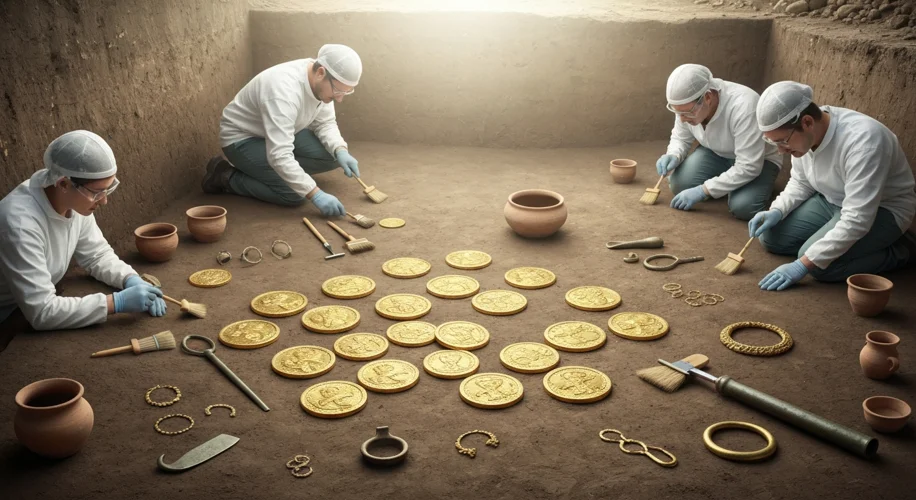Imagine a time when iron was giving way to bronze, and glittering gold was the currency of power and prestige. This was the world of the Celts, a people whose intricate art and fierce independence continue to fascinate us millennia later. And nestled within the earth, waiting for discovery, lay a treasure that would speak volumes about their sophisticated society: the ‘Rainbow Cup’ coin hoard.
For over two thousand years, this remarkable artifact lay hidden, a silent testament to a lost era. Its story begins around the 2nd century BCE, a period of significant upheaval and change across Europe. Celtic tribes, from the misty shores of Britain to the fertile plains of Gaul and beyond, were not the ‘barbarians’ later Roman propaganda would portray. They were skilled artisans, shrewd traders, and formidable warriors, their societies organized around chieftains, druids, and complex social structures. Their art, characterized by swirling patterns and abstract designs, was unlike anything seen elsewhere, reflecting a deep connection to nature and a unique spiritual worldview.
It was within this vibrant Celtic world that the ‘Rainbow Cup’ coin was minted. This wasn’t just a piece of metal; it was a statement. The coin, a dazzling example of late Celtic gold work, is a type known as a Regenbogenschüsselchen, or ‘Rainbow Cup,’ a name derived from its distinctive, almost iridescent sheen when unearthed and its bowl-like shape. These coins are believed to have originated in the regions of modern-day Germany and Bohemia.

The design of these coins is mesmerizing. Typically, they feature a central boss, often surrounded by radiating lines or concentric circles, mimicking the appearance of a miniature sun or a stylized rainbow. The edges are usually decorated with intricate swirling patterns, a hallmark of Celtic art. The gold itself is often of high purity, suggesting access to rich ore sources and sophisticated metallurgical skills. The sheer amount of gold contained within these coins also points to a significant level of wealth and economic activity among the Celtic elites.
What did these coins represent to the Celts? Their exact purpose remains a subject of scholarly debate. Were they purely for economic exchange, a high-value currency for significant transactions? Or did they hold a deeper, perhaps ritualistic or symbolic meaning? The name ‘Rainbow Cup’ itself hints at a connection to the celestial, to luck, or to the divine. Some archaeologists theorize that they may have been offered as votive gifts to deities, buried in sacred sites, or even used in ceremonial contexts.
Their discovery near Leipzig, Germany, in 2019, was nothing short of spectacular. A metal detectorist, scanning a field, stumbled upon not just one coin, but a hoard of 111 of these extraordinary ‘Rainbow Cup’ coins, along with other gold artifacts. The sheer quantity was astonishing, representing one of the largest hoards of its kind ever found. The circumstances of its burial are equally intriguing. It’s likely that this treasure was deliberately hidden, perhaps by a chieftain or a wealthy individual, during a time of unrest or impending danger. The intention was almost certainly to retrieve it later, but for reasons unknown, the owner never returned.
Imagine the moment of discovery: the glint of gold beneath the soil, the careful excavation, the slow revelation of a treasure trove that had lain undisturbed for millennia. The coins, remarkably preserved, still held that characteristic sheen that gave them their name, a faint echo of the sunlight that once shone on their original owners.

The ‘Rainbow Cup’ hoard is more than just a collection of ancient coins; it’s a window into the past. It provides invaluable insights into the economic systems, artistic achievements, and possibly even the belief systems of Celtic societies. The high purity of the gold and the consistency of the designs across the hoard suggest a well-established minting tradition. The presence of other gold items alongside the coins further enriches our understanding of Celtic wealth and craftsmanship.
Furthermore, the discovery fuels ongoing research into Celtic history. It allows historians and archaeologists to refine their understanding of trade routes, tribal territories, and the influence of Roman expansion on Celtic culture. Each coin, a tiny piece of history, tells a story of a vibrant people who left an indelible mark on the European landscape.
The journey of these ‘Rainbow Cup’ coins from their creation over 2,000 years ago to their rediscovery today is a powerful reminder of the ephemeral nature of human endeavors and the enduring power of artifacts to connect us to our past. They are whispers from the earth, telling tales of opulence, mystery, and the sophisticated world of the ancient Celts. As these treasures find their place in museums, they continue to inspire awe and ignite our imaginations, beckoning us to learn more about the people who crafted and cherished them.

